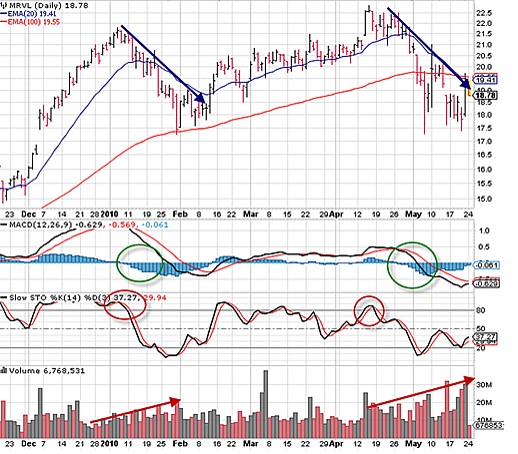Trading volume is the number of trades for a security in a given time frame. On a chart volume is typically represented as a histogram (vertical bars) and represents a confirmation or lack thereof of the other technical indicators. For example, if a moving average breaks below support on high volume, it is more significant than if the event took place on low volume. Volume can also serve as a red flag if a stock is trending higher on decreasing volume. We also want to confirm that there is adequate trading volume for our stocks and options to ensure the best opportunities for favorable price executions. In the screenshot, note how the accelerating volume is confirming a series of bearish signals:

Volume Bars Confirming Bearish Signals
Most traders are familiar with trading volume but many have never been introduced to the term deliverable volume.
What is deliverable volume?
This is the actual percentage of total trading volume that results in transfer of shares from one account to another’s. Stated differently, ownership is actually transferred. For stocks, deliverable rate is quite high because a buyer wants to buy and a seller wants to sell and so a transaction occurs with ultimate delivery of the underlying.
When is trading volume high but deliverable volume low?
This occurs when shares are bought and sold multiple times for the same date. The credits and debits are netted against each other and only the difference is settled.
These scenarios fall into 3 categories:
- Lots of day-trading with little intent to actually own the underlying
- Initial Public Offerings (IPOs)
- Newly-listed stocks
IPOs and newly-listed stocks do not have the history necessary to gain entrance onto our watch lists while stocks that are day-traded are usually highly volatile and speculative and therefore inappropriate for conservative option-selling strategies.
How to interpret deliverable volume
- Bullish: Increase in deliverable % with high volume and price increase
- Bearish: Decrease in deliverable % with a price decline
Discussion
The percentage of deliverable stocks reflect the interest of long-term investors in taking positions with the underlying. The stocks we deal with in our covered call writing and put-selling portfolios generally do not fall into the 3 categories where the percentage of deliverables is significantly lower than normal. Confirming adequate stock and option trading liquidity is where we must be most focused.
Market tone
This week’s economic news of importance:
- Case-Shiller home prices up 6.2 for October
- Consumer confidence index came in at 122.1
- Pending home sales for November 0.2%
- Weekly jobless claims for week ending 12/23 came in at 239,000, below expectations
- The stock market moved up 19.42% for the calendar year 2017
THE WEEK AHEAD
Mon Jan 1st
- None New Years Day
Tue Jan 2nd
- Markit Manufacturing PMI for Dec
Wed Jan 3rd
- Consumer spending
- ADP employment
- ISM manufacturing
- Construction spending
Thu Jan 4th
- Weekly jobless claims
- Markit services PMI for Dec
Fri Jan 5th
- Nonfarm payrolls
- Unemployment rate
- Foreign trade deficit
- Ism manufacturing
- Factory orders
For the week, the S&P 500 declined by 0.36% for a year-to-date return of 19.42%
Summary
IBD: Market in confirmed uptrend
GMI: 6/6- Buy signal since market close of August 31, 2017
BCI: My portfolio makeup moves to a bullish, selling 2 out-of-the-money strikes for every 1 in-the-money strike.
WHAT THE BROAD MARKET INDICATORS (S&P 500 AND VIX) ARE TELLING US
The 6-month charts point to a neutral outlook. In the past six months, the S&P 500 was up 10% while the VIX (11.04) moved down by 1%.
Wishing you a prosperous 2018,
